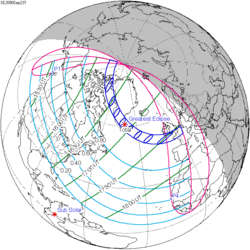Top Qs
Timeline
Chat
Perspective
Solar eclipse of November 1, 1948
Total eclipse From Wikipedia, the free encyclopedia
Remove ads
A total solar eclipse occurred at the Moon's descending node of orbit on Monday, November 1, 1948,[1] with a magnitude of 1.0231. A solar eclipse occurs when the Moon passes between Earth and the Sun, thereby totally or partly obscuring the image of the Sun for a viewer on Earth. A total solar eclipse occurs when the Moon's apparent diameter is larger than the Sun's, blocking all direct sunlight, turning day into darkness. Totality occurs in a narrow path across Earth's surface, with the partial solar eclipse visible over a surrounding region thousands of kilometres wide. Occurring about 2.4 days after perigee (on October 29, 1948, at 21:20 UTC), the Moon's apparent diameter was larger.[2]
Totality was visible from Belgian Congo (today's DR Congo), Uganda Protectorate (today's Uganda) including the capital city Kampala, British Kenya (today's Kenya) including the capital city Nairobi, British Seychelles (today's Seychelles), and British Mauritius (today's Mauritius). A partial eclipse was visible for parts of East Africa, Southern Africa, Antarctica, and Australia.
During this eclipse, comet C/1948 V1, also known as the Eclipse Comet of 1948, was discovered shining near the Sun.[3]
Remove ads
Eclipse details
Summarize
Perspective
Shown below are two tables displaying details about this particular solar eclipse. The first table outlines times at which the Moon's penumbra or umbra attains the specific parameter, and the second table describes various other parameters pertaining to this eclipse.[4]
Remove ads
Eclipse season
This eclipse is part of an eclipse season, a period, roughly every six months, when eclipses occur. Only two (or occasionally three) eclipse seasons occur each year, and each season lasts about 35 days and repeats just short of six months (173 days) later; thus two full eclipse seasons always occur each year. Either two or three eclipses happen each eclipse season. In the sequence below, each eclipse is separated by a fortnight.
Remove ads
Related eclipses
Eclipses in 1948
- A partial lunar eclipse on April 23.
- An annular solar eclipse on May 9.
- A penumbral lunar eclipse on October 18.
- A total solar eclipse on November 1.
Metonic
- Preceded by: Solar eclipse of January 14, 1945
- Followed by: Solar eclipse of August 20, 1952
Tzolkinex
- Preceded by: Solar eclipse of September 21, 1941
- Followed by: Solar eclipse of December 14, 1955
Half-Saros
- Preceded by: Lunar eclipse of October 28, 1939
- Followed by: Lunar eclipse of November 7, 1957
Tritos
- Preceded by: Solar eclipse of December 2, 1937
- Followed by: Solar eclipse of October 2, 1959
Solar Saros 142
- Preceded by: Solar eclipse of October 21, 1930
- Followed by: Solar eclipse of November 12, 1966
Inex
- Preceded by: Solar eclipse of November 22, 1919
- Followed by: Solar eclipse of October 12, 1977
Triad
- Preceded by: Solar eclipse of December 31, 1861
- Followed by: Solar eclipse of September 2, 2035
Solar eclipses of 1946–1949
This eclipse is a member of a semester series. An eclipse in a semester series of solar eclipses repeats approximately every 177 days and 4 hours (a semester) at alternating nodes of the Moon's orbit.[5]
The partial solar eclipses on January 3, 1946 and June 29, 1946 occur in the previous lunar year eclipse set.
Saros 142
This eclipse is a part of Saros series 142, repeating every 18 years, 11 days, and containing 72 events. The series started with a partial solar eclipse on April 17, 1624. It contains a hybrid eclipse on July 14, 1768, and total eclipses from July 25, 1786 through October 29, 2543. There are no annular eclipses in this set. The series ends at member 72 as a partial eclipse on June 5, 2904. Its eclipses are tabulated in three columns; every third eclipse in the same column is one exeligmos apart, so they all cast shadows over approximately the same parts of the Earth.
The longest duration of totality will be produced by member 38 at 6 minutes, 34 seconds on May 28, 2291. All eclipses in this series occur at the Moon’s descending node of orbit.[6]
Metonic series
The metonic series repeats eclipses every 19 years (6939.69 days), lasting about 5 cycles. Eclipses occur in nearly the same calendar date. In addition, the octon subseries repeats 1/5 of that or every 3.8 years (1387.94 days). All eclipses in this table occur at the Moon's descending node.
Tritos series
This eclipse is a part of a tritos cycle, repeating at alternating nodes every 135 synodic months (≈ 3986.63 days, or 11 years minus 1 month). Their appearance and longitude are irregular due to a lack of synchronization with the anomalistic month (period of perigee), but groupings of 3 tritos cycles (≈ 33 years minus 3 months) come close (≈ 434.044 anomalistic months), so eclipses are similar in these groupings.
The partial solar eclipses on December 18, 2188 (part of Saros 164) and November 18, 2199 (part of Saros 165) are also a part of this series but are not included in the table below.
Inex series
This eclipse is a part of the long period inex cycle, repeating at alternating nodes, every 358 synodic months (≈ 10,571.95 days, or 29 years minus 20 days). Their appearance and longitude are irregular due to a lack of synchronization with the anomalistic month (period of perigee). However, groupings of 3 inex cycles (≈ 87 years minus 2 months) comes close (≈ 1,151.02 anomalistic months), so eclipses are similar in these groupings.
Remove ads
Notes
References
Wikiwand - on
Seamless Wikipedia browsing. On steroids.
Remove ads































































































